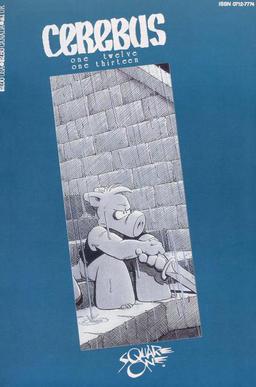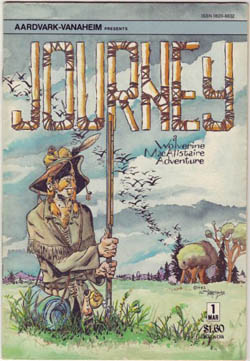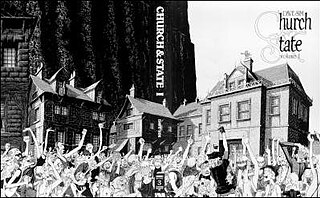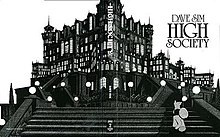
Cerebus is a comic book series, created by Canadian cartoonist Dave Sim, which ran from December 1977 until March 2004. The title character of the 300-issue series is an anthropomorphic aardvark who takes on a number of roles throughout the series—barbarian, prime minister, and pope among them. The series stands out for its experimentation in form and content, and for the dexterity of its artwork, especially after background artist Gerhard joined with the 65th issue. As the series progressed, it increasingly became a platform for Sim's controversial beliefs.

Gerhard is the professional name of a Canadian artist known for the elaborately detailed background illustrations in the comics series Cerebus the Aardvark.

Dave Sim is a Canadian cartoonist and publisher, known for his comic book Cerebus, his artistic experimentation, his advocacy of self-publishing and creators' rights, and his controversial political and philosophical beliefs.

Alternative comics or independent comics cover a range of American comics that have appeared since the 1980s, following the underground comix movement of the late 1960s and early 1970s. Alternative comics present an alternative to mainstream superhero comics which in the past have dominated the American comic book industry. They span across a wide range of genres, artistic styles, and subjects.
The Jack Kirby Comics Industry Awards were a set of awards for achievement in comic books, presented from 1985 to 1987. Voted on by comic-book professionals, the Kirby awards were the first such awards since the Shazam Awards ceased in 1975. Sponsored by Amazing Heroes magazine, and managed by Amazing Heroes managing editor Dave Olbrich, the Kirby Awards were named after the pioneering writer and artist Jack Kirby.

Flaming Carrot Comics is an American superhero comic book created by Bob Burden, featuring the absurd, surreal adventures of the Flaming Carrot.

Jim Valentino is an American writer, penciler, editor and publisher of comic books, best known for his 1990–1992 work on Guardians of the Galaxy for Marvel Comics, and for co-founding Image Comics, a company publishing creator-owned comics.
Aardvark-Vanaheim is a Canadian independent comic book publisher founded in 1977 by Dave Sim and Deni Loubert and is best known for publishing Sim's Cerebus.
Renegade Press was an American comic book company, founded by Canadian Deni Loubert, that operated from 1984 to 1988. Notable titles published by Renegade included Flaming Carrot, Ms. Tree, and normalman.

Journey: The Adventures of Wolverine MacAlistaire is an independent comic book created by William Messner-Loebs about Michigan frontier life in the 19th century. An ensemble piece, it tells the story of the Fort Miami settlement and the characters, both real and fictional, that occupy it. Among these is the title character, Joshua "Wolverine" MacAlistaire.
glamourpuss is a Canadian independent comic book written and illustrated by Dave Sim which was published from April 2008 to July 2012 and ran for 26 issues. The comic was published bimonthly, with 24 pages of story and art, and back issues remaining available throughout the comic's print run. The premise of the book is threefold: a parody of fashion magazines, a history of photorealism in comics, and a surreal super-heroine comic.
William D. Schanes is an American publishing executive, active for many years in the comic book industry. One of the founders of Pacific Comics, Schanes later worked for many years for Diamond Comic Distributors.

Denise "Deni" Loubert is a Canadian comics publisher, co-founder of Aardvark-Vanaheim, and founder of Renegade Press. She is the ex-wife of Dave Sim, with whom she founded Aardvark-Vanaheim and published Cerebus from issues #1 to #77 (1977–1985).
Cerebus is the first collected volume of Canadian cartoonist Dave Sim's Cerebus comic book series. It is made up of the first 25 issues of Cerebus, plus, as of the 11th edition, some strips that ran in Comics Buyer's Guide featuring Silverspoon, a parody of the comic strip Prince Valiant.

Church & State is the third novel in Canadian cartoonist Dave Sim's Cerebus comic book series. In it, Cerebus once again becomes Prime Minister, and eventually Pope. The story was published in individual issues from July 1983 to June 1988 (#111).

Jaka's Story is the fourth major storyline in Canadian cartoonist Dave Sim's Cerebus comics series.

Melmoth is the fifth novel in Canadian cartoonist Dave Sim's Cerebus comic book series. It follows Oscar in his last days leading up until his death, while Cerebus sits catatonic, clutching the doll of Jaka, the woman he loves but believes has been killed.

Mothers & Daughters: a novel is the sixth novel in Canadian cartoonist Dave Sim's Cerebus comic book series. Sim considers the novel to be the final portion of the main story. It collects Cerebus #151–200 in four volumes, the seventh through tenth volumes of the paperback "phone book" collections of the series, titled Flight, Women, Reads and Minds.

Rick's Story is the eighth novel in Canadian cartoonist Dave Sim's Cerebus comic book series. It is made up of issues #220-231 of Cerebus. It was collected as Rick's Story in one volume in November 1998, and was the 12th collected "phonebook" volume.
Cerebus phonebooks are the paperback collections that Dave Sim has collected his comic book series Cerebus in since 1986. They have come to be known as "phonebooks" as their thickness and paper stock resemble that of phone books. The format had a large influence on alternative comics publishing and was key in the move from the periodical-centric publishing style that was once dominant.













